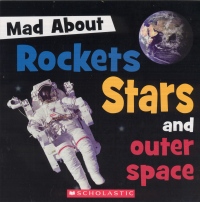| ________________
CM . . .
. Volume XVI Number 11. . . .November 13, 2009 
 |
Mad About Rockets, Stars and Outer Space!
Toronto, ON: Scholastic Canada, 2009.
20 pp., pbk., $4.99.
ISBN 978-0-545-98015-9.
Subject Headings:
Solar system-Juvenile literature.
Stars-Juvenile literature.
Outer space-Juvenile literature.
Grades 3-5 / Ages 8-10.
Review by Bruce Dyck.
**½ /4
|
| |
|

excerpt:
The solar system started forming over four billion years ago! Today, it contains the Sun, moons, asteroids, comets, and all the planets, including our world, which is called Earth.
Mad About Rockets, Stars and Outer Space! is a brief, brightly illustrated book about, you guessed it, outer space. Each two-page spread deals with a general topic, introducing in simple language and using a key-word approach, general outer space concepts. Our galaxy, the solar system, and our sun are the first three topics. The next two deal with the rocky planets and the gas planets. Comets and asteroids come next, followed by a section devoted to our moon and the International Space Station. The book concludes with a two-page "Search and Find" and a one-page "Guess who?" quiz.
As is my habit, I'll cover the book's strengths first. At the top of the list is the majority of the book's imagery, including the text. The font used is kid-friendly and yet still readable for those with less than youthful eyes, something that is not always the case. The readability and clarity of the text are an issue that is overlooked too often. Having watched several grandparents struggle to read poorly thought out text to a grandchild, this has become an issue for me, and the number of dark coloured pictures, and coloured text boxes used throughout Mad About Rockets, Stars and Outer Space! provide a pretty good example of how to do this well.
Another positive thing abouts Mad About Rockets, Stars and Outer Space! is that it manages to pack a lot of content into a very small space. Most of the important outer space topics are covered, including the demotion of Pluto from planetary status.
Mad About Rockets, Stars and Outer Space! also makes a big effort to utilize comparative measurements to attempt to give the reader a sense of scale. Unfortunately, it takes the idea too far. The book begins well by explaining that the over 1 billion stars in our galaxy equals 10 stars for each person on earth, but very quickly the authors jettison the numerical information entirely and begin to rely entirely on comparative measurement, to the point that the numerical information is indecipherable. An example of this can be seen in how the temperature of the surface of our sun is given. The temperature, stated comparatively as 250 times hotter than the earth, could be misleading. A child using this information and making the assumption that the Sun is actually 250 times hotter then it is outside today, could then, incorrectly, place the sun's surface temperature between -7500E°C ( -30E° x 250) and 7500E°C ( 30E° x 250). (The actual temperature is approximately 6000E°C.), and while it might seem to some like I'm nitpicking here, it is simply that the information is misleading, and so easily fixed by the addition of a "real" number.
There is one surprising omission in Mad About Rockets, Stars and Outer Space! Given the title, one would expect to find some information about rockets. If one were to hold this assumption, then one would be disappointed. Other than a brief mention of the Space Shuttle, which, while it uses rocket boosters to achieve orbit, is not a rocket itself, and a single sentence mentioning Apollo 11 in the section devoted to the moon, there is no information at all given on rockets. Perhaps Mad About Stars and Outer Space would have been a better title, either that, or replacing the section on the International Space Station, with a section on Rockets.
My last complaint is perhaps the one thing that irritated me the most. The artwork in the second last section looks like somebody copied a fast-food kid's activity sheet, and the publisher's choice to include four American flags as some of the objects the reader is supposed to find, is beyond me. As well, if I was being really picky, the graphic used to represent the planetary orbits is the typical "mobile style " with all of the planets orbiting the Sun in concentric rings that are perfectly parallel to each other. It would have be nice to have an illustration that is a better representation of the actual orbit; however, the reality is that the target audience would probably finds the "mobile style" easier to understand.
Recommended.
Bruce Dyck is currently employed by his wife and two sons as a stay-at-home dad in Winnipeg, MB.

To comment
on this title or this review, send mail to cm@umanitoba.ca.
Copyright © the Manitoba Library Association. Reproduction for personal
use is permitted only if this copyright notice is maintained. Any
other reproduction is prohibited without permission.
NEXT REVIEW |
TABLE OF CONTENTS FOR THIS ISSUE
- November 13, 2009.
AUTHORS |
TITLES |
MEDIA REVIEWS |
PROFILES |
BACK ISSUES |
SEARCH |
CMARCHIVE |
HOME |
